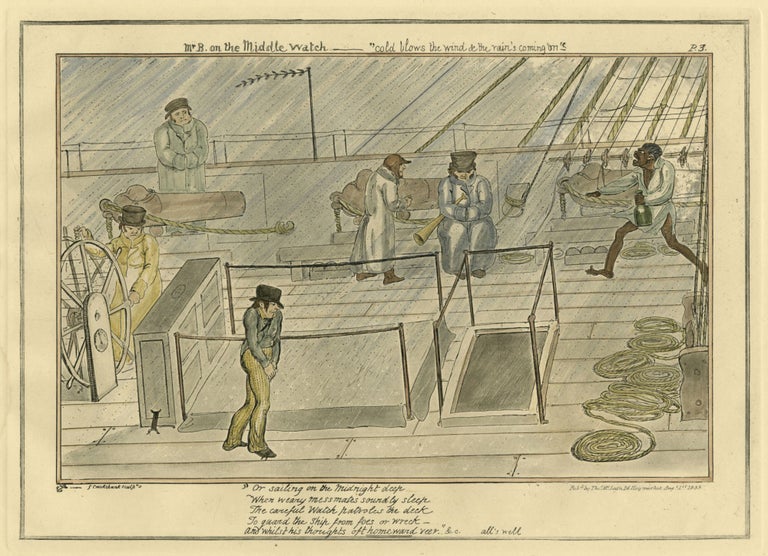
Mr. B. on the Middle Watch- "cold blows the wind & the rain's coming on."; From, The Progress of a Midshipman, Exemplified in the Career of Master Blockhead 1860 (plate 3)
London: Thomas McLean, 1835. Etching with handcoloring in watercolor on cream wove paper, 8 3/8 x 11 1/2 inches (210 x 290 mm), full margins. Second and final edition. Signed and in the plate by Cruikshank, and bearing Frederick Marryat's anchor moniker. Two large bows of light-colored dampstain, approximately 1/4 inch into the image area at the left plate mark (unobtrusive). Minor bow of light dampstaining at the lower center sheet edge, does not enter plate mark. Light handling creases and surface soil. All condition issues are consistent with age.
Perhaps introduced to each other by their mutual friend, Charles Dickens, George Cruikshank and Captain Frederick Marryat became fast friends, political confidants, and artistic collaborators, working together many times over the course of their late careers. Marryat, a novelist, caricaturist and captain in the Royal Navy, first went to sea in 1806, and served throughout the Napoleonic Wars. After Napoleon’s defeat, having had a brilliant career at sea, Marryat found his Naval exercises uninspiring, and decided to resign his commission. In November 1830 he left the Royal Navy and took up writing full time. Some of Marryat’s most well loved novels include "Frank Mildmay" (1829), "Peter Simple" (1834), "Mr. Midshipman Easy" (1836), and "Japhet in Search of a Father" (1836). Marryat was also a well known author of children’s books, having penned "The Pacha of many Tales" (1836), "The Phantom Ship" (1839), "Poor Jack" (1840), "Masterman Ready" (1841), and "The Settlers in Canada" (1844). He is also known for some unrelated remarkable achievements, including having developed the first general system of flag signaling for merchant vessels (Marryat’s Code of Signals), as well as being credited with describing a previously unrecorded gastropod genus Cyclostrema with the type species Cyclostrema cancellatum, and having drawn Napoleon’s deathbed portrait.
Originally issued in an oblong folio with 11 sheets containing 12 hand-colored plates by Cruikshank after watercolors by Marryat, this image is signed in the plate, and dated August 1835. The impression, from the second (and final) edition, was published by in London by Thomas McLean in 1835.
Item number: 167
Price: $500.00
Share: